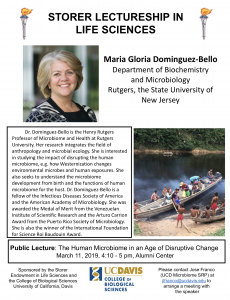How microbial profiles differ between water-damaged and dry buildings is not well known. It’s only logical that where moisture is available indoors, microorganism will grow. Yet, measured microbial products do not show consistent differences between wet and dry homes. Because wet homes are associated with a variety of health risks, it’s important to identify the …
Maria Gloria Dominguez-Bello gave a talk at UC Davis on March 11, 2019. This talk was part of the Storer Lectureship in Life Sciences series. Her talk was on “The Human Microbiome in an Age of Disruptive Change” and it was really quite good. I live Tweeted the talk and if you are interested the …
Following the success of the first Microbiology of the Built Environment Gordon Research Conference this past summer, we are excited to announce that the second meeting is scheduled during the week of June 7 – 12, 2020 at Proctor Academy, Andover, NH. Save the dates and more information to follow!
The Alfred P. Sloan Foundation has approved a grant to host a workshop on viruses in the built environment. Building on the success of the foundation’s Microbiology of the Built Environment program, the workshop will convene researchers from academia and government agencies to address questions about the viral community and its dynamics in the built …
Source: Opinion | Discovering the Great Indoors Definitely worth checking out this opinion piece in the NY Times bye Rob Dunn on “Discovering the Great Indoors”. It has a bit about Van Leeuwenhoek, and bits about fungi and lice and bacteria and tardigrades and foldscope and more. Rob Dunn is really one of the great …
This highly-anticipated study on the effect of natural daylight treatments on whole bacterial communities in household dust from the University of Oregon’s Biology and the Built Environment Center is now available! Daylight exposure modulates bacterial communities associated with household dust Ashkaan K. Fahimipour , Erica M. Hartmann, Andrew Siemens, Jeff Kline, David A. Levin, Hannah Wilson, Clarisse …
I am compiling information on past, present and future “Citizen Microbiology” projects. Basically I am looking for examples of projects that could fit VERY BROADLY into the concept of citizen or participatory science and involve microbes. Examples include: Participatory Research Classes such as SeaPhages https://seaphages.org Tiny Earth https://tinyearth.wisc.edu Human Microbiome Sample Crowdsourcing The American Gut Project http://americangut.org …
Another NASEM meeting of possible interest. Both in person and online, October 22nd, 2018. Here’s a link to the registration. We invite you to join the open session of our fourth committee meeting. At the meeting we will hear from the U.S. Department of Veterans Affairs (DVA) on implementation of their 2014 directive. We will also hear …
Days 4 and 5 of the meeting were a real mix of things including chemistry, evolution, and ‘omics. Also Kevin Bonham took fairly detailed notes throughout the entire conference and put those all online here, worth checking out if you want more detail. Started off the day with Mohamed S. Donia from Princeton University, “Small …
Day 3 of the meeting was virus day! Viruses have often gotten short shrift at these kinds of meeting, especially once 16S rRNA sequencing took over the microbial world. But the balance is shifting back, largely because of metagenomics. First up was Andrew J. Hryckowian from Stanford University “Bacteriodes thetaiotaomicron as a Chassis for Understanding …


